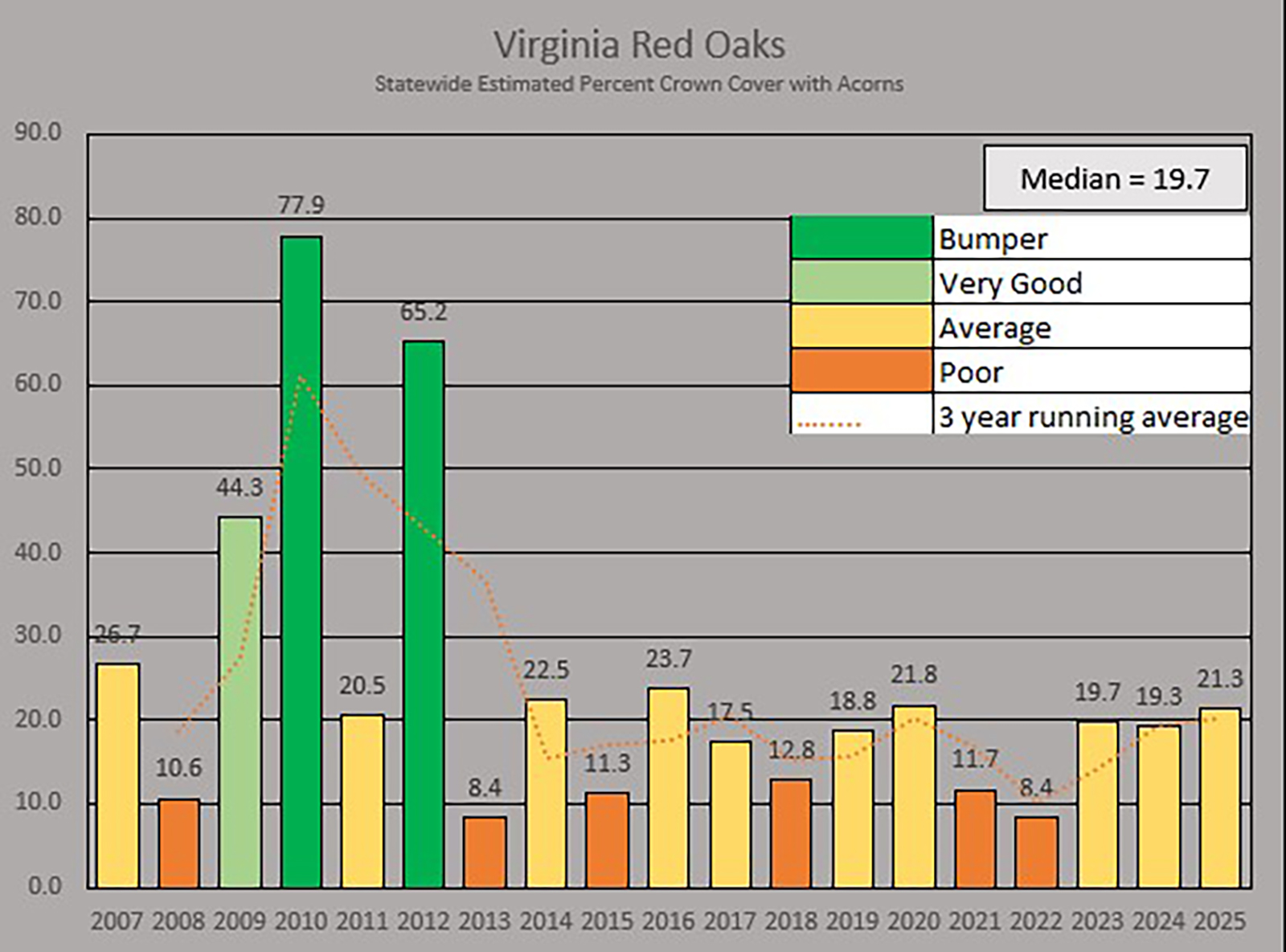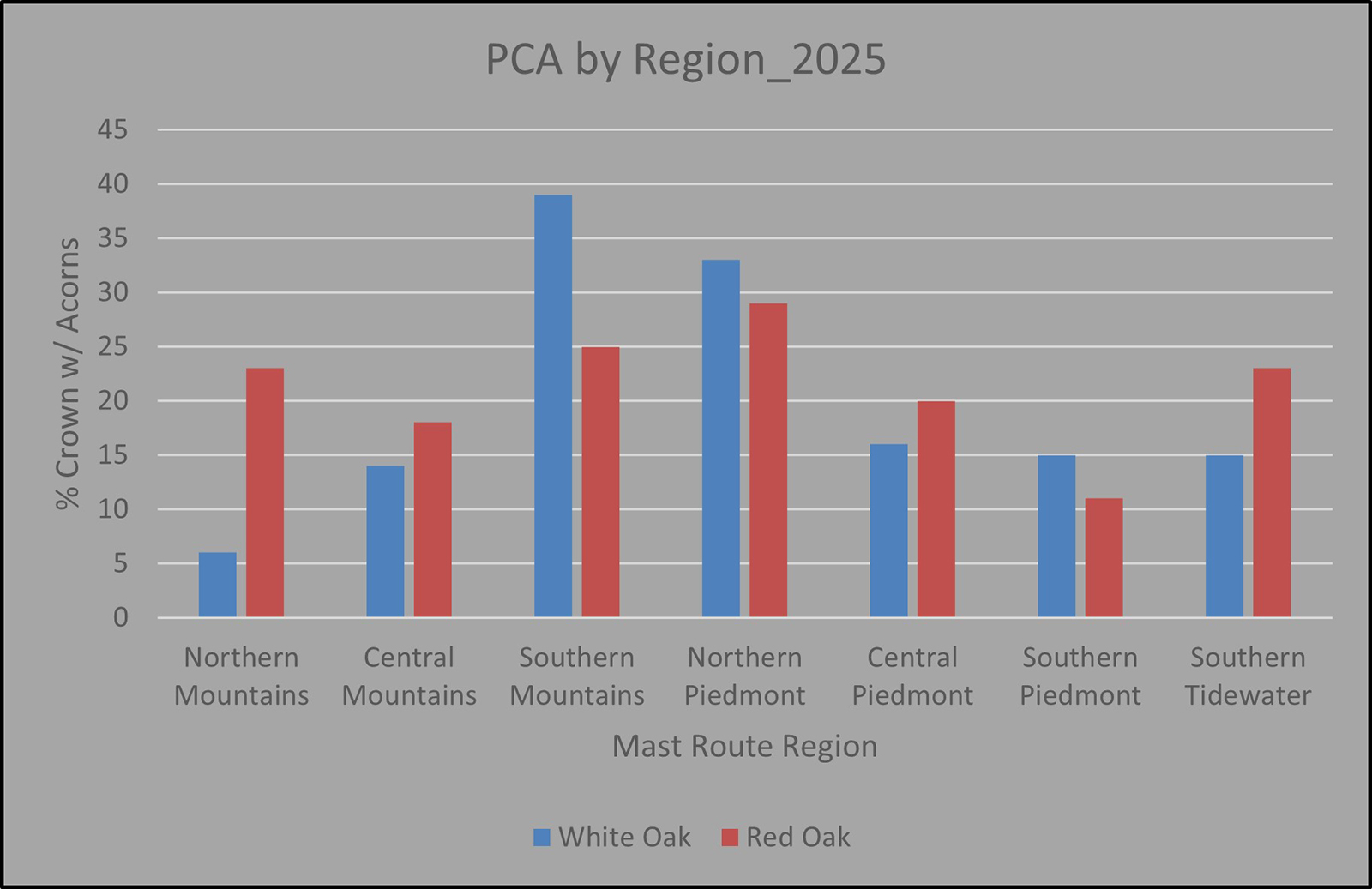2025 Acorn Production Report: Sweet Music to the Ear
By Katie Martin/DWR
The “music” of fall for many wildlife species is the sound of acorns raining down from the trees. In most years, the steady “plop, plop” begins in early September and can continue, depending on the crop, through October. On calm days, they fall steadily as singles or pairs; but on a rainy, blustery day they can pour from the sky, leaving “marble yards” to navigate across in their path. Live under or near a metal-roofed structure in a bumper year and you may be reaching for ear plugs to block out the crack and pings as they bounce to the ground.
But for white-tailed deer, blue jays, ruffed grouse, wild turkeys, black bears, woodrats, squirrels (of all varieties), and numerous other species, these sounds are the ringing of the dinner bell and a signal to forage now in preparation for the upcoming winter. Whether you’re a hunter preparing for the upcoming seasons or a wildlife enthusiast enjoying crisp hiking days, read on to learn about the acorn outlook for 2025 in Virginia. The Cliff notes version… there should be quite a bit of music in the woods this fall!
Acorn production across Virginia in 2025 can be categorized overall as very good for white oak species and average for red oak species (Figures 1-5). Based on the annual hard mast survey, white oak routes climbed to above average with an index of 22, which is well above the all-time low recorded in 2023 (3.3) and significantly higher than the 8.6 recorded in 2024. While the long-term median production from 2007 to 2025 for white oaks is 10.2, the 10-year median of 9.2 is more reflective of masting conditions over the past decade. This year’s white oak index of 22 exceeds this new “normal,” highlighting a bumper year across many survey routes.

Statewide white oak acorn production (average percent of tree crowns with acorns), presented as long-term median (2007-2025) with 95% confidence intervals.
Red oaks surveyed have remained stable since 2023, with a slight increase this year to 21.3 from their surveyed index of 19.3 in 2024. This aligns with the long-term red oak median of 19.7 and above the 10-year median of 19.1.

Statewide red oak acorn production (average percent of tree crowns with acorns), presented as long-term median (2007-2025) with 95% confidence intervals.
White oak production was fairly consistent across the state, with most routes reporting above-average production. The best production was found in the Southern Mountains and Northern Piedmont regions, while the lowest production was noted in the Northern Mountains. Above long-term average production was noted in all other regions (Central Mountains, Central and Southern Piedmont, and South Tidewater). Several routes recorded their highest index for white oak production in over a decade.

Statewide white oak acorn production (PCA) broken into categorical rankings based on four-group cluster analysis with 95% confidence intervals.
Red oak production was average or slightly above average in all areas except for the Southern Piedmont (which fell below the long-term average). Most routes exhibited highly consistent red oak production statewide. While red oak acorns are not generally preferred by many wildlife species due to their tannin content (and size), in years of poor white oak production, these acorns will often be readily consumed, especially later in the season. Red oak acorns germinate the following spring, thus giving wildlife additional time to consume them before they sprout into a seedling.

Statewide red oak acorn production (PCA) broken into categorical rankings based on four-group cluster analysis with 95% confidence intervals.
As with all years, acorn production is highly variable and very site dependent. White oaks exhibited this variability by having areas of “bumper” mast production even within routes that were overall noted as below average. This variability is due to many reasons (weather, insects, tree species), but for some of our survey sites we are probably approaching the biological end of production due to tree age. Unfortunately, finding “new” stands of mature oak in the 50- to 70-year-old age range is becoming more and more difficult due to aging forests and lack of sufficient regeneration.
Replacing aging trees/survey sites could be quite a challenge moving forward. While most of Virginia experienced sufficient rainfall early in the spring and summer of 2025, drought conditions became prevalent across the state by mid-July. While these late growing season drought conditions don’t normally impact acorn production, drought stress can impact when acorns begin falling and contribute to overall tree decline, particularly for aging trees.
The annual hard mast survey has been an ongoing effort between the Virginia Department of Wildlife Resources (DWR) and many partner agencies for many years. Many of the mountain survey sites have been in place since the 1950s. In 2025, staff from DWR, the U.S. Forest Service, U.S. Fish and Wildlife Service, Virginia Department of Conservation and Recreation-State Parks, Virginia Department of Forestry, U.S. Department of Defense/Department of Military Affairs, National Park Service, and Smithsonian Conservation Biology Institute surveyed 32 hard mast production sites across Virginia. Sites are located across all regions of the state, although a majority are currently found in the mountains. Continued efforts are being made to add sites to the Northern Piedmont and Tidewater areas.
Production by Region: White Oak (Appendix 1)
- Mountains: White oak production across the Mountain region (18 survey sites) was variable, with poor production in the northern areas and above average production in the southern mountains. While the northern routes were below average, they did increase from severe lows in 2023 and 2024. Many of the southern mountain routes were above average, with excellent production noted across all elevations and aspects. Oak regeneration is a serious conservation issue in all of these areas and ongoing habitat management efforts have been underway by DWR and partner agencies to enhance areas with significant oak decline.
- Piedmont: White oak production across the Piedmont (11 sites) was more variable than the Mountain region, with all three areas recording above average production. The highest production was found in the Northern Piedmont, but the Southern and Central Piedmont areas were also highly productive. Pockets of poor production were noted across all routes, with one route (White Oak Wildlife Management Area) recording near zero production across all white oaks surveyed. Several Northern Piedmont routes recorded 100% (bumper) trees, which was a first for many of these routes in over a decade.
- Tidewater: The Tidewater area has our lowest sample size with three sites. In 2025, two of the three sites were below average, while one exceeded the average. This is about on par with past survey lows for this area and follows the boom-and-bust cycle of white oaks. With low sample numbers it’s hard to make any solid conclusions about acorn production in this area, but reports of excellent soft mast production were noted throughout this area all summer.
Production by Region: Red Oak (Appendix 2)
- Mountains: Red oak production was close to average or above average across many of the mountain sites, although several routes in each region fell well below the long-term average. The southern mountain routes had the best production for the Mountain region along with mid-slope routes in the Northern Mountain region.
- Piedmont: Red oak production was above the long-term median in two out of the three Piedmont zones surveyed, with only the Southern Piedmont falling short of the average. Production across all sites trended slightly higher than that found in the Mountain region with several routes averaging around 40%. The Northern Piedmont recorded some of the highest red oak production in 2025 across the state, which is consistent with white oak production this year as well.
- Tidewater: The Tidewater region averaged well above the long-term median across all three sites, although one site (Southampton) recorded below average production. Red oak production in this region has tended to trend below that of the other regions since routes were initiated here. Production for two out of the three routes, though, reached near-record highs for this area.

Regional red and white oak production (PCA) for 2025.
What does all of this mean for hunters and wildlife viewers for the fall of 2025? Due to the abundance of acorns across many areas of the state, many wildlife species will likely be less mobile throughout the fall as they target these high-calorie food sources. This can make them less visible to both hunters and other outdoor recreationists as they may not use open fields, food plots, and other early successional habitats as readily. Secondary hard mast sources such as hickory, beech, and chestnuts (primarily Chinese chestnut) were in abundance across much of the state, as were soft mast species such as blackberries, blueberries, pokeberry, wild grapes, paw-paws, persimmons, dogwood, and black gum fruits. This means many wildlife species should be in excellent condition as they enter the winter after feasting on many of these food sources all fall.
Katie Martin is DWR’s Deer-Bear-Turkey Biologist.
Legal Disclaimer:
EIN Presswire provides this news content "as is" without warranty of any kind. We do not accept any responsibility or liability for the accuracy, content, images, videos, licenses, completeness, legality, or reliability of the information contained in this article. If you have any complaints or copyright issues related to this article, kindly contact the author above.
